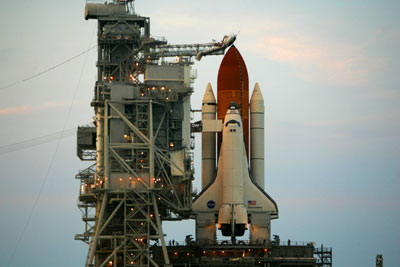Thunderstorms forced NASA to call off the launch of space shuttle Discovery
on Saturday, a flight already tense over worries that foam could fall from the
external fuel tank and endanger the mission.
Another attempt at what would be the first shuttle launch in a year was
planned for Sunday, although bad weather was forecast to continue through the
Independence Day weekend.
Storm clouds moved in and out of the launch zone throughout the morning and
early afternoon, posing lightning threats. As the countdown held at the
nine-minute mark, it became clear the weather would not improve, and launch
director Mike Leinbach announced a 24-hour delay.
The seven astronauts aboard the fueled spaceship immediately halted their
launch procedures. "It wasn't our time today," shuttle commander Steven Lindsey
radioed from the cockpit. "We'll launch when we're ready and, hopefully,
tomorrow will look better."
The delay was a disappointment for NASA, which last flew the shuttle last
July and was eager to get flights to the international space station back on
track.
The only technical problem that arose during the countdown was a failed
heater for one of Discovery's thrusters, needed to keep the fuel from freezing.
Mission managers decided to proceed with the launch, since the thruster was not
needed during liftoff, and work around the problem in orbit.
As it has since the Columbia disaster, the overriding
concern remained the foam insulation on the external fuel tank.

The
space shuttle Discovery sits on the launch pad at the Kennedy Space Center
in Cape Canaveral, Florida June 30, 2006. The launch for the crew of seven
astronauts is scheduled for July 1. [Reuters] |
NASA Administrator Michael Griffin decided to proceed with the 12-day mission
despite the concerns of two top agency managers who wanted additional foam
repairs.
"We now have a NASA in which senior officials feel free to discuss and debate
openly complex, difficult and subtle technical topics that affect the flight,"
Griffin told The Associated Press on Saturday. "No matter what decision I made,
I would have been disappointing somebody."
Bryan O'Connor, the top safety officer, and chief engineer Christopher
Scolese recommended at a meeting two weeks ago that the shuttle remain grounded
until design changes are made to 34 areas on the fuel tank known as ice-frost
ramps. The wedge-shaped pieces of foam insulate brackets on the tank that hold
long pressurization lines in place. The intent is to keep ice or frost from
forming on the metal brackets once the tank is filled with super-cold fuel.
Griffin noted that the foam is important, "shame on us that we didn't
realize it before" the Columbia tragedy. But he stressed that it is hardly the
only thing that poses a flight risk.
If foam came off and struck Discovery, causing serious damage, the seven
astronauts could move into the space station and await a rescue by shuttle
Atlantis. But that would be risky, too, and something NASA would try to avoid if
at all possible.
On Saturday, NASA had just five minutes to launch the shuttle because of the
need to intercept the international space station in orbit. The next launch
attempt was scheduled for 3:26 p.m. EDT Sunday.
Among the space agency's guests at the launch were Vice President Dick Cheney
and several members of Congress.
"It's a great program and it's important that we keep going and keep our
space program going," said Cheney, who was accompanied by his wife, Lynne, and
three of their grandchildren. The family got to see shuttle Atlantis up-close in
the hangar.